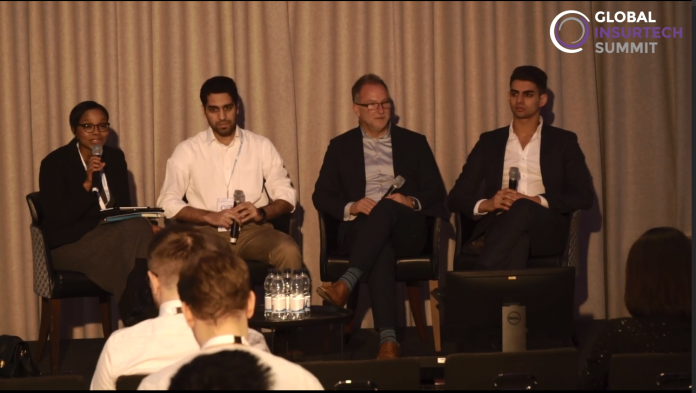Building an on-demand insurance solution which provides a service rather than a ‘contract’ is how the space will evolve, according to a panel at the Global InsurTech Summit 2019.
Appetite in insurance technology has been steadily increasing since 2014, but last year saw investment skyrocket, FinTech Global data shows. A total of $3.1bn was invested in the space during 2018, nearly double the $1.6bn invested over the course of 2017. Among the excitement in technology, a new style of insurance has taken form, an on-demand insurance policy. Definitions of the specific characteristics of an on-demand insurance product can differ from a generalistic term defining any policy capable of being bought quickly and entirely digitally or more focused around a policy which can start and stop and is based on usage. The panel at the Global InsurTech Summit discussed the opportunities the space is offering.
The panel consisted Startupbootcamp InsurTech London programme director Tshidi Hagan, Admiral Group international business development manager Armaghan Ahmed, AXA partners UK head of innovation Milan Sud and Slice Labs chief growth officer Philippe Lafreniere.
Slice Labs is a Germany-based on-demand insurance startup which provides insurers with tools to offer their customers instant coverage. The company’s chief growth officer Philippe Lafreniere explained to the audience that an insurer wanting to implement on-demand services must closely examine what it is they want to deliver. If they want a customer to engage with them, they need to provide value and give them a service that warrants any kind of interaction.
He said, “Generally, we don’t really care about engagement with our insurer. With traditional products I buy a policy, I may pay my bill once a month, that might be an automatic debit, in most places, or an automatic credit card payment, and then a year from now I’ll receive a renewal. In an on-demand world, in on-demand policies you have more of an interaction.
“With our cyber product, as an example, we make sure that we deliver values. So how do we get the policy holder to interact with us? They’re only going to interact with us and they’re only going to use an App or the cyber health check dashboard, if there is value to them. So, if it’s an on-demand automobile policy, are you showing me the impact of my driving habits? Are you showing me how I can reduce or better my driving, and then reduce my premium? For a cyber policy, we are showing people how they rank against their peers.”
Giving consumers a real reason for loading up the app and interacting with an insurer is how insurance can evolve to become more like a service. Simply having an app that lets a policyholder view their insurance details or buy a new product will not get them using it that frequently. More interactions with a consumer will make them more likely to come back for future insurance. A dashboard like Slice Labs’ lets users monitor their behaviour and access information on how they can improve this and in turn lower future premiums. He added, “you cannot take your existing process, the existing way that you do business and think that all of a sudden people are going to flock to your website or your app.”
On-demand insurance platforms have contributed to the high levels of funding. The second largest European InsurTech deal in 2018 was completed by on-demand insurance platform Coya which bagged $30m through a Series A. The startup gives consumers the ability to cover their household contents and bicycle when they need to. Slice Labs was another company in the space to close its Series A last year, netting $20m.
Interest isn’t just localised across Europe. Across the pond, US-based Metromile landed $90m for its Series E round. Drivers can leverage Metromile to pay for insurance per the mile they drive and receive protection for bodily harm, property damage, collision, uninsured motorise cover, and emergency roadside assistance, among others. Similar to Slice Labs, the company engages customers through its mobile app by offering them a sense of value. Its app gives data on trip times, how they can improve drives and monitor the vehicle health.
Admiral Group’s Armaghan Ahmed said, “A lot of times people get harped on, oh, we’ll get an app and people will come. I’m not going to check my app to check my policy. You almost have to provide some incremental service.”
Providing the example of UK-based health insurance app Vitality, Ahmed continued to explain how it is essential for on-demand services to give customers a reason for interacting. Vitality gives consumers offers for gyms or certain discounts promoting a healthy lifestyle and their consumers are taking advantage of these opportunities. Consumers are getting healthier, while insurers can improve loss ratios and better select risks from improved interactions and profiling. Both sides get the benefit from the communication.
He added, “Focusing on the service or what value can I bring for the customer, is very important. It’s not about saying, oh, I will build an app. It’s about saying, well why will people keep coming to my app? So, I think that’s the part that we all need to figure out. I think insurance is still early in that stage where a lot of it is our pricing, the way our processes have been set up. It’s traditionally been about, you get a customer and then you keep him for five, six years. So, you’d often discount the policy at your business and then you’d sort of increase at renewal. So as transparency increases, as sort of these new alternative ecosystems approaches, and as these new competitors emerge sort of with all this funding, I think the traditional players will have to put their rules at the same game as well.”
On-demand insurance is not just for InsurTechs, and a handful of traditional insurance players are making their presence in the space. Last year, Aviva was the latest to join the market, releasing the subscription-styled insurance product AvivaPlus. Even those on the panel, AXA and Admiral Group, are working in the space. Admiral Group is powering the short-term car insurance platform Veygo, which lets learners, or car sharers, get quick cover for driving the vehicle for a couple of hours up to 90 days.
AXA also operates within the on-demand insurance industry, providing coverage through the US startup Trov. The company lets users protect their headphones, wearables, tablets, phones, cameras, laptops and photography equipment for however long they need.
In the world of on-demand, AXA partners’ Milan Sud said the enterprise was moving away from the idea of just supplying an insurance contract and more towards giving them an actual service. This means not just giving them cover and that being it but supplying them with something useful.
Sud said, “An example of this is something we’ve done in the motor space, which was, we went out to speak to customers about, not their car insurance, but actually their relationship with their vehicle and what it was that they were finding difficult in terms of vehicle ownership. And the thing that came back loud and clear was we find it really difficult when it comes to vehicle repair and maintenance.”
He continued, “We said, right, how do we take the pain out of that for customers? And it was around providing a service where we’ll pick up their vehicle from wherever they want it picked up from, the work we’ve done that we keep digitally updated and then it will be dropped off wherever they want dropped off to. Now that’s providing an on-demand service, which isn’t in insurance contracts.”
This will be the next stage of insurance, he said. Instead of just reacting to events and paying claims, they can begin to engage with customers, give them more meaningful and personalised products. Eventually, it could lead to the industry becoming preventative and proactive, reducing the number of claims in general – helping to improve the world, rather than pay for repairs.
Risks of false claims in on-demand insurance
An audience member pitched a potential challenge for on-demand insurance to the panel, on whether buy-to-claim is a big issue for the space. This refers to someone taking out insurance, claiming instantly and then cancelling the cover.
Milan Sud from AXA partners said, “In a word yes, absolutely. As soon as you make a policy so easy to buy people will buy it retrospectively after they’ve broken something, and it will happen. And do I have the answer as to how we break that down and stop that happening? No. It’s such a new market, but we have to be focused to begin with on customer experience.
“So, we’ll start from the customer experience that is right. You will have to take a punt on these kinds of things. They potentially will lose you money to begin, but that’s why you do them on a smaller scale than going out to millions of customers at once, and understand how you tweak the journey to ensure that claims ratio doesn’t spiral out of control, but in a word yes it’s a real challenge in this market.”
There are some measures which can be taken by an insurance company in validating the time of damage, such as providing an image of the product in its current condition before taking out a policy. However, this is not 100 per cent secure and consumers could find ways of hoaxing the details, even if its simply providing an image of the product weeks before the damage. This is one of the challenges which insurers are working on solving, with new technology always coming out furthering an insurers ability to spot claim fraud.
Slice Labs’ Philippe Lafreniere added. “I agree with Milan on this. And one of the reasons why, I’ll say, in a way for now, we’ve stayed away from the gadget insurance, because we believe that that’s a big problem in this space where you’re really gambling against when did it happen, and we had a lot of thoughts and opinions about that as well, but it’s still early days and yes, as you said, I think the risks are there and it’s really about having good practices. So, one of the things that we have focused on as we look at this model is incorporating behavioural science mechanism.”
The company has been using these behavioural science techniques to not only improve identification fraud, but also its prevention. Furthermore, this can then be used to predict what might constitute or result in a claim, lowering the chance of people attempting to buy-to-claim.
Copyright © 2019 FinTech Global











